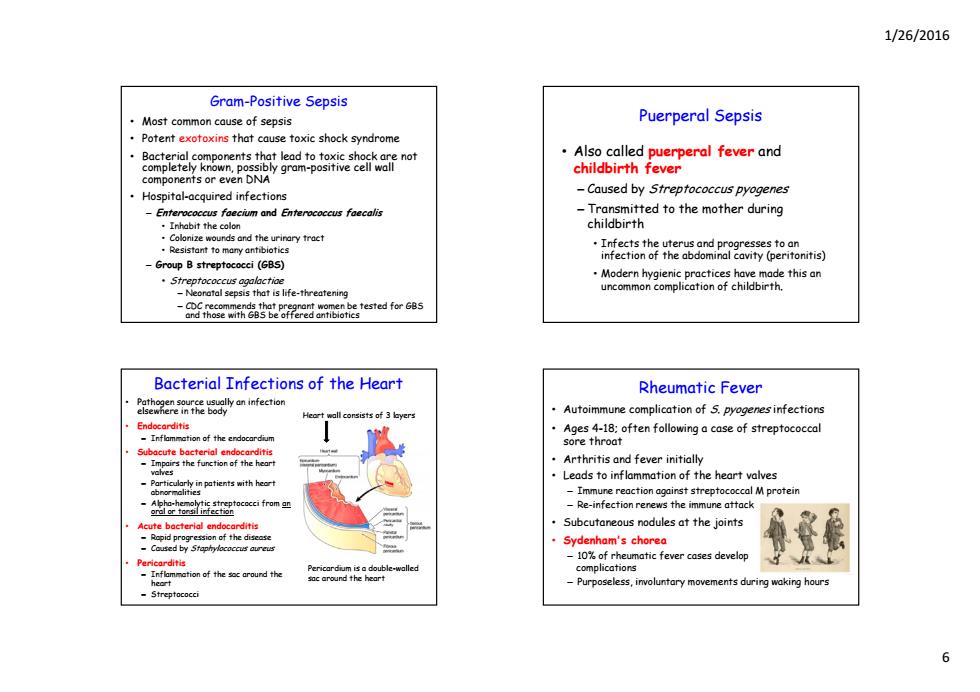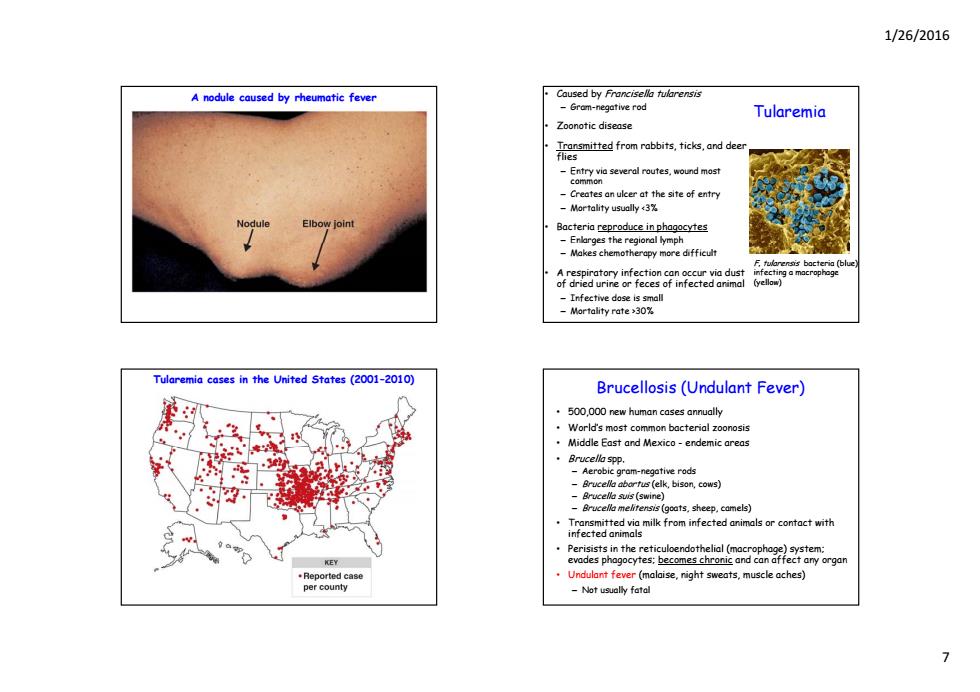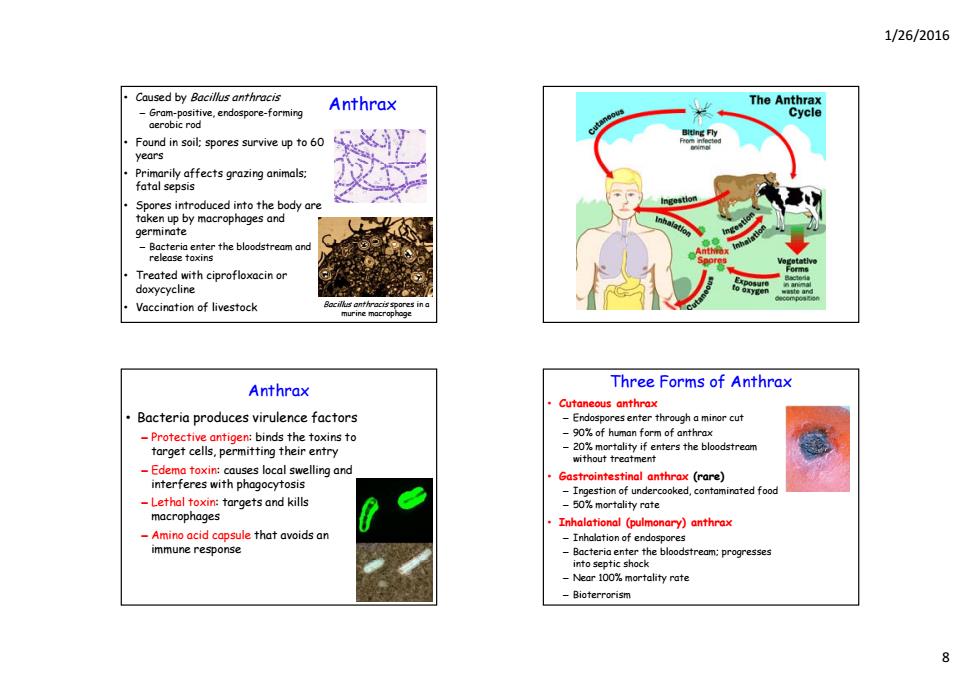
1/26/2016 Gram-Positive Sepsis Most common cause of sepsis Puerperal Sepsis Potent exotoxins that cause toxic shock syndrome ·8a+2ae2anps7l5adpeoet8k8eot Also called puerperal fever and childbirth fever components or even DNA Hospital-acquired infections -Caused by Streptococcus pyogenes -Transmitted to the mother during ·Inhabit the colon childbirth Colonize wounds and the urinary tract Resistant to many antibiotics -Group B streptococci(GBS) ·年ec6go6rt间 Streptococcus agalactioe Modern hygienic practices have made this an -Neonatal sepsis that is life-threatening uncommon complication of childbirth. Bacterial Infections of the Heart Rheumatic Fever 2g黑能onimtecTion wall o时3yer Autoimmune complication of 5.pyogenes infections Ages 4-18:often following a case of streptococcal sore throat Arthritis and fever initially Leads to inflammation of the heart valves -Immune reaction against streptococcal M protein -Re-infection renews the immune attack Acute bacterial endocarditis Subcutaneous nodules at the joints Ropid progression of the disease Sydenham's chorea -Coused by Staphylococcus aureus -10%of rheumatic fever cases develop Pericarditis -Inflammation of the arourd the Pericardium is a double-walled complications sac around the heart -Purposeless,involuntary mo ts du ing waking hours 6
1/26/2016 6 Gram-Positive Sepsis • Most common cause of sepsis • Potent exotoxins that cause toxic shock syndrome • Bacterial components that lead to toxic shock are not compl t l k ibl letely known, possibl y gram-positi ll ll itive cell wall components or even DNA • Hospital-acquired infections – Enterococcus faecium and Enterococcus faecalis • Inhabit the colon • Colonize wounds and the urinary tract • Resistant to many antibiotics – Group B streptococci (GBS) • Streptococcus agalactiae – Neonatal sepsis that is life-threatening – CDC recommends that pregnant women be tested for GBS and those with GBS be offered antibiotics Puerperal Sepsis • Also called puerperal fever and childbi th f hildbi rth fever – Caused by Streptococcus pyogenes – Transmitted to the mother during childbirth • Infects the uterus and progresses to an infection of the abdominal cavity (peritonitis) • Modern hygienic practices have made this an uncommon complication of childbirth. Bacterial Infections of the Heart • Pathogen source usually an infection elsewhere in the body • Endocarditis – Inflammation of the endocardium Heart wall consists of 3 layers • Subacute bacterial endocarditis – Impairs the function of the heart valves – Particularly in patients with heart abnormalities – Alpha-hemolytic streptococci from an oral or tonsil infection • Acute bacterial endocarditis – Rapid progression of the disease – Caused by Staphylococcus aureus • Pericarditis – Inflammation of the sac around the heart – Streptococci Pericardium is a double-walled sac around the heart Rheumatic Fever • Autoimmune complication of S. pyogenes infections • Ages 4-18; often following a case of streptococcal sore throat • Arthritis and fever initially • Leads to inflammation of the heart valves – Immune reaction against streptococcal M protein – Re-infection renews the immune attack • Subcutaneous nodules at the joints • Sydenham's chorea – 10% of rheumatic fever cases develop complications – Purposeless, involuntary movements during waking hours

1/26/2016 A nodule caused by rheumatic fever Caused by Francisella tularensis -Gram-negative rod Tularemia Zoonotic disease -Creates an ulcer at the site of entry -Mortality usually3% Nodule wjoint Bacteria reproduce in phagocytes -Enlarges the regioral lymph -Makes chemotherapy more difficult -Infective dose is small -Mortality rate>30% Tularemia cases in the United States(2001-2010) Brucellosis(Undulant Fever) 500,000 new human cases annually World's most common bacterial zoonosis Middle East and Mexico-endemic areas Brucella spp. -Aerobic gram-negative rods -Brucella abartus(elk,bison,cows) Brucella suis (swine) -Brucella melitensis (goats,sheep,camels) Perisists in the reticuloendothelial(macrophage)system: KEY evades phagocytes;becomes chronic and can affect any organ Undulant fever (malaise,night sweats,muscle aches) er county Not usually fatal 1
1/26/2016 7 A nodule caused by rheumatic fever Tularemia • Caused by Francisella tularensis – Gram-negative rod • Zoonotic disease • Transmitted from rabbits, ticks, and deer flies – Entry via several routes, wound most common – Creates an ulcer at the site of entry – Mortality usually <3% • Bacteria reproduce in phagocytes – Enlarg g yp es the regional lymph – Makes chemotherapy more difficult • A respiratory infection can occur via dust of dried urine or feces of infected animal – Infective dose is small – Mortality rate >30% F. tularensis bacteria (blue) infecting a macrophage (yellow) Tularemia cases in the United States (2001–2010) Brucellosis (Undulant Fever) • 500,000 new human cases annually • World’s most common bacterial zoonosis • Middle East and Mexico - endemic areas • Brucella spp. – Aerobic gram-negative rods – Brucella abortus (elk, bison, cows) – Brucella suis (swine) – Brucella melitensis (goats, sheep, camels) • Transm m fmf m w itted via milk from infected animals or contact with infected animals • Perisists in the reticuloendothelial (macrophage) system; evades phagocytes; becomes chronic and can affect any organ • Undulant fever (malaise, night sweats, muscle aches) – Not usually fatal

1/26/2016 Caused by Bacillus anthracis The Anthrax -Gram-positive,endospore-forming Anthrax Cycle aerobic rod Found in soil:spores survive up to 60 years Primarily affects grazing animals: fatal sepsis Spores introduced into the body are taken up by macrophages and germinate -Bacteria enter the bloodstream and release toxins Treated with ciprofloxacin or doxycycline Vaccination of livestock Anthrax Three Forms of Anthrax Cutaneous anthrax Bacteria produces virulence factors -Endospores enter through a minor cut -Protective antigen:binds the toxins to -90%of human form of anthrax target cells,permitting their entry -20%mortality if enters the bloodstream without freatment -Edema toxin:causes local swelling and interferes with phagocytosis Gastrointestinal anthrax(rare) Ingestion of undercooked.contaminated food -Lethal toxin:targets and kills -50%mortality rate macrophages Inhalational((pulmonary)anthrax Amino acid capsule that avoids an -Inhalation of endospores immune response -Bacteria enter the bloodstream:progresses into sept tic shock Near 100%mortality rate Bioterrorism
1/26/2016 8 Anthrax • Caused by Bacillus anthracis – Gram-positive, endospore-forming aerobic rod • Found in soil; spores survive up to 60 years • Primarily affects grazing animals; fatal sepsis • Spores introduced into the body are taken up by macrophages and germinate – B t i t th bl d t d Bacteria enter the bloodstream and release toxins • Treated with ciprofloxacin or doxycycline • Vaccination of livestock Bacillus anthracis spores in a murine macrophage Anthrax • Bacteria produces virulence factors – Protective antigen: binds the toxins to t t ll itti th i t target cells, permitting their entry – Edema toxin: causes local swelling and interferes with phagocytosis – Lethal toxin: targets and kills macrophages – Amino acid capsule that avoids an immune response Three Forms of Anthrax • Cutaneous anthrax – Endospores enter through a minor cut – 90% of human form of anthrax – 20% mortality if enters the bloodstream without treatment • Gastrointestinal anthrax (rare) – Ingestion of undercooked, contaminated food – 50% mortality rate • Inhalational (pulmonary) anthrax – Inhalation of endospores – Bacteria enter the bloodstream; progresses into septic shock – Near 100% mortality rate – Bioterrorism